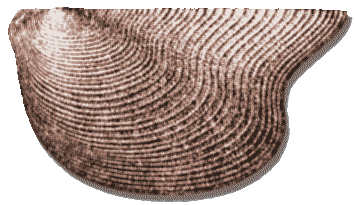Geology / Gallery

Pteronitella retroflexa (13)
The Bivalves ➚ are an abundant and important type of Gastropod. The name 'bivalve' is, for once, a useful descriptive term, the shell is in two symmetric halves hinged on one edge and is a familiar sea-side shell. They include oysters, scallops and clams.
Like many invertebrate organisms ➚ the main groups developed during the Cambrian period and have remained fairly constant ever since. Bivalve species seem to be relatively stable over millions of years and do not evolve rapidly and so have limited value as stratigraphic markers. Normally only the 'shell' is preserved but it is the internal soft parts that give a much better clue as to their classification within this very large group of animals.
Some bivalves live by burrowing in soft mud, others by cementing themselves to rock and a few are free swimming.
Pteronitella retroflexa lived in the Ordovician and Silurian and can be found in the UK.
| Division | Name |
| Phylum | Mollusca |
| Class | Bivalvia |
| SubClass | Pteriomorphia |
| Order | Pterioida |
Fossil gallery
- Brittle Star : Lapworthia miltoni
- Trilobite : Dalmanites myops
- Crinoid : Eucalyptocrinites decorus
- Gastropod : Poleumita discorus
- Trilobite : Calymene blumenbachi
- Graptolite : Cyrtograptus murchisoni
- Sponge : Ischadites koenigi
- Conodont : Ozarkodina typica
- Brachiopod : Pentamerus oblongus
- Graptolite : Petalograptus minor
- Brachiopod : Chonetes striatellus
- Cystoid : Lepocrinetes quadrifasciatus
- Bivalve : Pteronitella retroflexa
- Graptolite : Monograptus lobiferus
- Gastropod : Platyceras haliotis
- Crinoid : Sagenocrinites expansus
- Brachiopod : Atrypa reticularis
